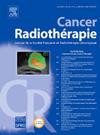鼻咽癌静态与动态调强放疗的比较:剂量学及正常组织并发症概率分析
IF 1.4
4区 医学
Q4 ONCOLOGY
引用次数: 0
摘要
目的随着鼻咽癌放疗技术的进步,有必要对体积调弧治疗与调强放疗的疗效进行比较。本研究旨在评估两种技术治疗鼻咽癌的剂量学和放射生物学差异。材料与方法回顾性研究125例鼻咽癌患者的调强放疗和调容弧线治疗方案。剂量学评价采用剂量-体积直方图参数,放射生物学分析采用正常组织并发症概率模型。比较两种技术的靶覆盖率(达到高危计划靶体积95%的剂量)、危及器官的平均剂量和最大剂量以及正常组织并发症的概率值。结果调强放疗和调容弧线治疗的剂量学结果相当。体积调制弧线治疗在某些参数上具有优势,较高的剂量可达到95%的高危计划目标体积,而对左右视神经、交叉和晶状体的最大剂量较低。相反,调强放疗能更好地保留腮腺,导致较低的正常组织并发症概率值。调强放疗对喉部、咽部和甲状腺的平均剂量也较低。结果在鼻咽癌早期和晚期亚组中保持一致。结论调强放疗与调容弧线治疗在鼻咽癌治疗中均有明显优势。两种技术保护的危险器官各不相同。放射生物学参数,包括正常组织并发症概率模型和剂量测量,突出了每种技术的不同益处。本文章由计算机程序翻译,如有差异,请以英文原文为准。
Comparison of static and dynamic intensity-modulated radiotherapy for nasopharyngeal carcinoma: Dosimetric and normal tissue complication probability analysis
Purpose
With the advancement of radiotherapy techniques for nasopharyngeal carcinoma, it is essential to evaluate the comparative effectiveness of volumetric-modulated arc therapy and intensity-modulated radiotherapy. This study aimed to evaluate the dosimetric and radiobiological differences between the two techniques for the treatment of nasopharyngeal carcinomas.
Materials and methods
This retrospective study involved replanning of 125 cases of nasopharyngeal carcinoma using both intensity-modulated radiotherapy and volumetric-modulated arc therapy techniques. Dosimetric evaluation was performed using dose–volume histogram parameters, while radiobiological analysis was conducted using normal tissue complication probability models. Target coverage (dose delivered to 95 % of the high-risk planning target volume), mean dose, and maximum dose to organs at risk, as well as normal tissue complication probability values, were compared between the two techniques.
Results
Both intensity-modulated radiotherapy and volumetric-modulated arc therapy provided comparable dosimetric outcomes. Volumetric-modulated arc therapy showed advantages in certain parameters, with a higher dose delivered to 95 % of the high-risk planning target volume and lower maximum dose for the right and left optic nerves, chiasma, and lenses. Conversely, intensity-modulated radiotherapy provided better sparing of the parotid glands, resulting in lower normal tissue complication probability values. The larynx, pharynx, and thyroid also received lower mean doses with intensity-modulated radiotherapy. The results remained consistent in subgroups of both early and advanced stages of nasopharyngeal carcinoma.
Conclusion
Intensity-modulated radiotherapy and volumetric-modulated arc therapy both have distinct advantages in treating nasopharyngeal carcinoma. Organs at risk protected vary between the two techniques. The radiobiological parameters, including normal tissue complication probability models and dosimetric measures, highlight the differential benefits of each technique.
求助全文
通过发布文献求助,成功后即可免费获取论文全文。
去求助
来源期刊

Cancer Radiotherapie
医学-核医学
CiteScore
2.20
自引率
23.10%
发文量
129
审稿时长
63 days
期刊介绍:
Cancer/radiothérapie se veut d''abord et avant tout un organe francophone de publication des travaux de recherche en radiothérapie. La revue a pour objectif de diffuser les informations majeures sur les travaux de recherche en cancérologie et tout ce qui touche de près ou de loin au traitement du cancer par les radiations : technologie, radiophysique, radiobiologie et radiothérapie clinique.
 求助内容:
求助内容: 应助结果提醒方式:
应助结果提醒方式:


